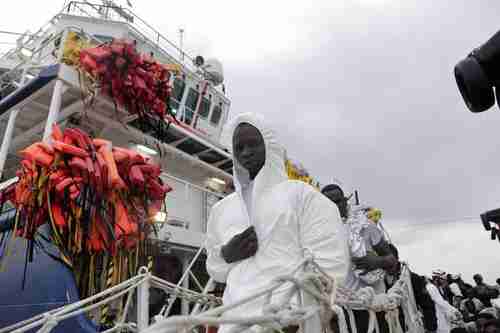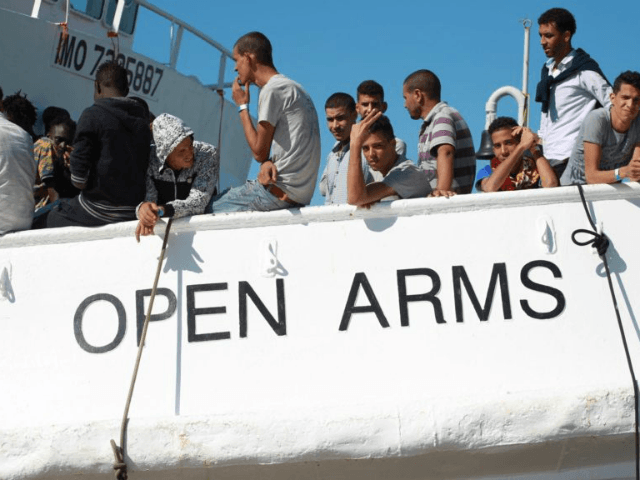This morning’s key headlines from GenerationalDynamics.com
- Europe and North America overwhelmed by growing migration crisis
- New techniques for ethnic cleansing and genocide
- The increasing threat of ‘unspeakable’ violence from MS-13
Europe and North America overwhelmed by growing migration crisis

From June 2017: Migrants from Africa arrive in Italy on a rescue ship
The U.N. High Commissioner for Refugees (UNHCR) reported that nearly 69 million people worldwide were forcibly displaced from their home in 2017. The number of displaced people has set a new world record each year for the last five years.
Of the 69 million total, 16.2 million were newly displaced in 2017, or more than 44,000 people per day. The High Commissioner, Filippo Grandi, said:
The global figure has gone up again by a couple of million. This is because of protracted conflicts and lack of solutions for those conflicts that continue, continuous pressure on civilians in countries of conflict that pushed them to leave their homes and new or aggravating crises, like the Rohingya crisis.
The Rohingya crisis refers to the genocide and ethnic cleansing occurring Burma (Myanmar), which has driven 905,000 ethnic Rohingyas from their homes in Rakhine State into refugee camps in Bangladesh. That is the fifth worst refugee crisis in the world today.
In fourth place is Venezuela, with 1.5 million refugees. The socialist government has almost completely destroyed Venezuela’s economy, forcing 1.5 million people from their homes into neighboring countries. More than 600,000 people are newly displaced in neighboring Colombia, with an estimated 3,000 people crossing the border each day in search of basic essentials and new opportunity.
In third place is South Sudan, with 2.1 million refugees, which is the largest refugee crisis in Africa. More than 4 million people have been uprooted from their homes since the start of a brutal civil war in 2013, including 2.1 million people who have been forced to cross into neighboring countries, the majority of them women and children.
In second place is Afghanistan, with 2.5 million refugees, who have been forced to leave the country for Iran, Pakistan, or Europe.
In first place, the biggest refugee crisis in the world, is Syria, with 5.6 million refugees, where president Bashar al-Assad uses barrel bombs laced with chlorine gas specifically targeting women and children, and also used Sarin gas to kill large numbers of civilians.
The number of displaced persons has been a record every year for the last five years, and this increasing trend line is expected to continue. CBS News and U.N. High Commissioner for Refugees (UNHCR) and Mercy Corps and Stockholm International Peace Research Institute (2004)
New techniques for ethnic cleansing and genocide
A new technique for committing ethnic cleansing and genocide is becoming increasingly common. The government violently attacks members of an ethnic or religious group, such as when they are peacefully protesting. Then when any members of the ethnic group react with violence to get revenge, the government starts referring to millions of people in the ethnic group, including women and children, as “terrorists” and starts performing ethnic cleansing, forcing millions of people into neighboring countries. This is currently happening in Syria and Burma (Myanmar), and in Cameroon to a lesser extent.
The growing use of new techniques for committing ethnic cleansing and genocide is part of a global increase in violent wars. In 2004, the Stockholm International Peace Research Institute reported that the number of wars in the world was decreasing and that 2003 had seen the fewest number of armed conflicts in 14 years, except for 1997. But since 2003, we have seen the number of armed conflicts increase, creating record numbers of displaced persons and refugees, overwhelming resources in many countries.
From the point of view of Generational Dynamics, this is what happens during a generational Crisis era, which began in 2003. A country enters a generational Crisis era when the survivors of the previous generational crisis war, in this case World War II, all disappear (retire or die). Examination of hundreds of examples throughout history shows that this happens 58 years after the end of the previous crisis war, and 2003 is 58 years after 1945, the end of World War II.
For years I have been writing how nationalism and xenophobia have been growing in Europe, America, and in countries around the world in a generational Crisis era. A related phenomenon is the overwhelming increase in migrants and refugees, which further stokes nationalism and xenophobia.
The same thing happened in the last generational Crisis era, in the 1930s. In July 1938, 32 nations met for a conference to address the problem of hundreds of thousands of German and Austrian Jews who were fleeing Naziism, or whom Hitler was expelling. Hitler actually mocked the conference participants in a speech when he said, “I can only hope and expect that the other world which has felt such deep sympathy for these criminals will be generous enough to transform this pity into practical aid. As far as I am concerned we are ready to place our luxury ships at the disposal of these countries for the transportation of these criminals.” In the end, Europe, North America, and Australia refused to take on refugees, saying that their population “density” had reached a point of “saturation.”
After the war, the Europeans signed the 1957 Treaty of Rome where, having suffered the devastation of two world wars and fearing a third, the European survivors saw as a major cause of those world wars the same nationalism and xenophobia that is increasingly prevalent today.
There are some countries today that are successfully hosting large numbers of refugees, according to UNHCR. For the fourth consecutive year in 2017, Turkey hosted the largest number of refugees worldwide, with 3.5 million people. It was followed by Pakistan (1.4 million), Uganda (1.4 million), Lebanon (998,900), Iran (979,400), Germany (970,400), Bangladesh (932,200) and Sudan (906,600).
However, many other countries have become overwhelmed by the large number of refugees and are taking political action to block the arrival of refugees and migrants. This has been true in the United States for years, and it is becoming the policy of an increasing number of “populist” elections in Europe, in countries such as Italy and Hungary.
From the point of view of Generational Dynamics, these political attempts are futile. Even if some temporary solution could be found, the trend line of increasing migration is going to continue in this generational Crisis era and any political solution that “solves” the problem this year will be overcome by more wars and new waves of migrants and refugees.
The increasing threat of ‘unspeakable’ violence from MS-13
Although forced displacement is a global problem, UNHCR is expressing special alarm at the sharp rise in forced displacement in Central America.
More than 294,000 asylum seekers and refugees from the north of Central America were registered globally as of the end of 2017, an increase of 58 percent from a year earlier. This is sixteen times more people than at the end of 2011.
The vast majority of those fleeing El Salvador, Guatemala, and Honduras are seeking refugee protection either to the north in Belize, Mexico, and the United States, or (and increasingly) to the south in Costa Rica and Panama. Many are vulnerable women or children either unaccompanied by or who have become separated from their families.
Of particular concern are MS-13 gangs in Central America traveling to the United States. A federal task force in Boston announced in January 2016 the dismantling of several local branches of the MS-13 street gang, including 56 gang members, a third of MS-13’s Massachusetts membership.
Described by federal officials as being guilty of unspeakable violence and enormous cruelty, the gang targets middle and high schoolers for initiation, officials said, especially in Chelsea, East Boston, and Everett high schools. The initiation requires the student to commit crimes, and to become a full-fledged member requires the commission of a significant crime, usually the murder of a rival gang member.
According to a Francesca Fontanini, a Mexico-based UNHCR spokesman, refugees from Central America come to escape violence:
The people who are coming are saying that the level of violence is brutal – they are basically confined to their own houses because there is a lack of freedom. It is very dangerous to go to school, to go to church, to move around. They are living in very traumatized and violent circumstances.
Unfortunately, if they become refugees in the United States, they are targeted by the same MS-13 gangs and the same brutal violence that they had hoped to escape from. UNHCR and Boston Globe (29-Jan-2016) and Boston Globe (29-Jan-2016) and Guardian (London, 22-May) and Institute for Research on Public Policy Policy (Canada)
Related Articles:
- Italy’s migration policy opens up battle lines within the EU (17-Jun-2018)
- Italy begs for help after 12,000 migrants arrive in four days (30-Jun-2017)
- EU migrant crisis moves to Italy as Austria begins closing border (13-Apr-2016)
- Canada’s Immigration and Refugee Board overwhelmed by migrants crossing border from US (20-Mar-2018)
- Canada receives record numbers of Mexican asylum seekers after Trudeau’s welcome tweet (13-May-2017)
- Thousands of migrants flee to Canada, fearing deportation in the US (04-Aug-2017)
KEYS: Generational Dynamics, U.N. High Commissioner for Refugees, UNHCR, Filippo Grandi, Burma, Myanmar, Venezuela, South Sudan, Afghanistan, Syria, Bashar al-Assad, Cameroon, Stockholm International Peace Research Institute, Hitler, Treaty of Rome, 1957, Turkey, Pakistan, Uganda, Lebanon, Iran, Germany, Bangladesh, MS-13, El Salvador, Guatemala, Honduras, Belize, Mexico, Boston, Chelsea, East Boston, Everett, Francesca Fontanini
Permanent web link to this article
Receive daily World View columns by e-mail

COMMENTS
Please let us know if you're having issues with commenting.